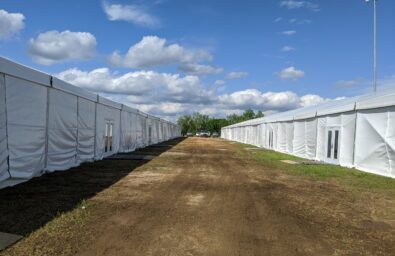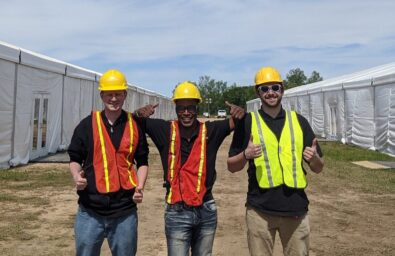covid-19 quarantine camp networkSurface Transport & Logistics

In the early days of the COVID-19 pandemic, our team was called upon to provide critical connectivity services for a government quarantine camp. The camp provided staging for government personnel returning to the US and for those about to be deployed to different parts of the world. The task? To build a stand-alone wired/wireless network to support 3000 personnel and their devices, be remotely managed from our headquarters, be weather resistant, and maintain operational capability for two years. The catch? We had to build it in the middle of a field with no existing infrastructure or internet connectivity.
challenge
Our team faced several challenges when building the network for the quarantine camp. First, we had to create a network from scratch in a field where there was no existing infrastructure or internet connectivity. This meant that we had to design and implement a complex integrated wired and wireless network that could support thousands of government personnel and their devices.
Second, we had to ensure that the network was secure and could protect data from unauthorized access or breaches. Third, we had to build the network to be robust and able to withstand the open environment and remain reliably functional in all weather conditions. Finally, we had to build the network to be remotely monitored and managed from our headquarters almost 1000 miles away, in order to reduce the need for on-site technical support.
solution
Our team went to went to work, designing per the established requirements while thinking outside of the box- to address elements that would not have been required, pre-pandemic. Generally, an onsite survey would have been conducted. However, due to the nature of emergency, TRG utilized a geobrowser to access satellite and aerial imagery over the internet to determine the best locations for the network components, including the access points, switches, and routers that would serve as the core. We designed the network architecture to include multiple access points that provided reliable coverage and redundancy throughout the quarantine camp.
We used well-placed high-performance networking equipment to ensure fast and reliable connectivity for the users, and we incorporated both wired and wireless connections to support various devices. To ensure the security of the network, we implemented strong encryption and access controls, and we set up firewalls and intrusion detection systems to monitor the network for any suspicious activity.
To make the network weather-resistant, we installed weather-resistant enclosures to protect the networking equipment from the elements. We also ensured that the network components were rated for outdoor use and could withstand a wide range of weather conditions.
Finally, we implemented a centralized management system which allowed us to monitor and manage the network from a remote location almost 1000 miles away. We also established a help desk to provide technical support to the personnel at the camp.
results

In the end, the successful implementation of the network was a testament to our company’s expertise and dedication. We were able to provide a very quick but solid solution that met the government’s requirements and exceeded their expectations in terms of reliability, security, and manageability. The network itself provided essential connectivity and support to the personnel in the camp, allowing them to work and communicate with their loved ones despite being physically separated. We were thrilled to have been a part of this project and to have contributed to the well-being and productivity of all.

